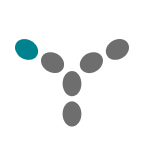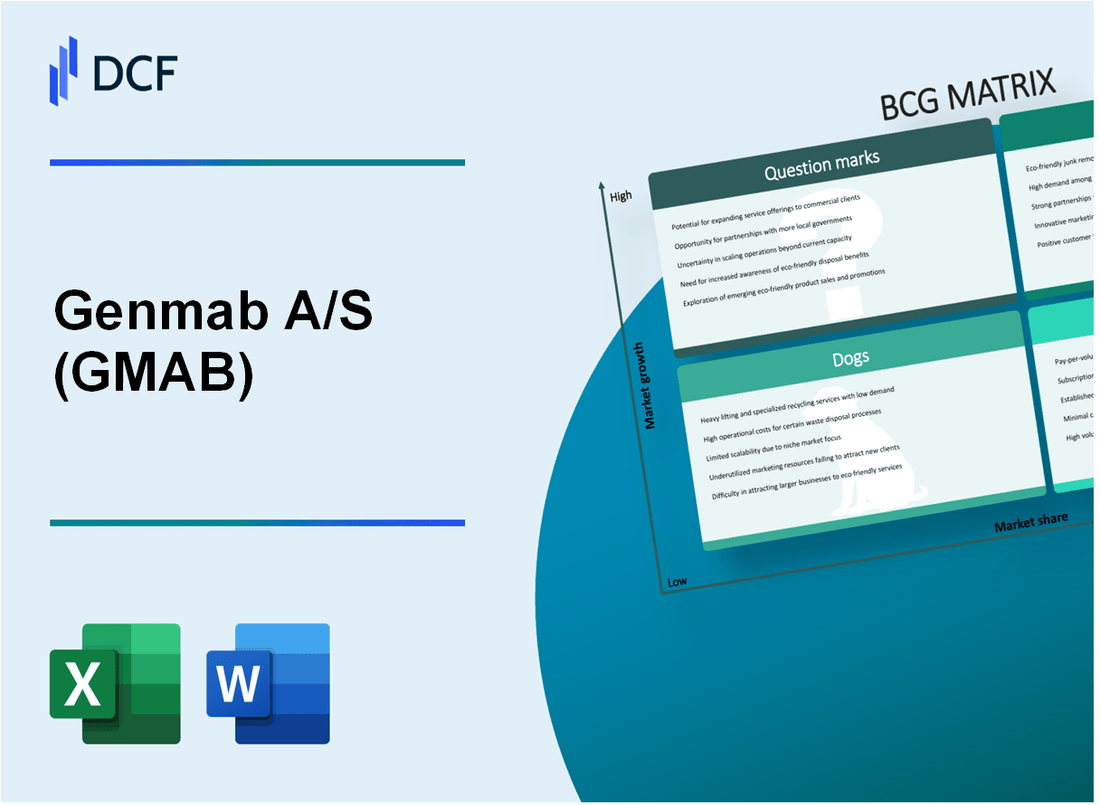
|
Genmab A/S (GMAB): BCG Matrix |

Fully Editable: Tailor To Your Needs In Excel Or Sheets
Professional Design: Trusted, Industry-Standard Templates
Investor-Approved Valuation Models
MAC/PC Compatible, Fully Unlocked
No Expertise Is Needed; Easy To Follow
Genmab A/S (GMAB) Bundle
In the dynamic world of biotechnology, Genmab A/S stands at the crossroads of innovation and strategic growth, with a diverse portfolio that spans from breakthrough cancer treatments to promising immunotherapy research. By examining the company's business through the lens of the Boston Consulting Group Matrix, we unveil a compelling narrative of strategic positioning, where blockbuster drugs like Daratumumab shine as Stars, reliable partnerships generate steady Cash Cow revenues, experimental technologies emerge as intriguing Question Marks, and legacy projects fade as Dogs in the competitive landscape of oncological therapeutics.
Background of Genmab A/S (GMAB)
Genmab A/S is a Danish biotechnology company founded in 1999 and headquartered in Copenhagen, Denmark. The company specializes in developing advanced antibody therapeutics for the treatment of cancer and other serious diseases. Genmab is recognized globally for its innovative approach to antibody research and development.
The company was established by Jan van de Winkel and Mads Krogsgaard Thomsen with a vision to create groundbreaking antibody technologies. Genmab is publicly traded on the Nasdaq Copenhagen Stock Exchange and has a secondary listing on the Nasdaq Global Select Market in the United States under the ticker symbol GMAB.
Genmab's core competencies include developing and commercializing antibody therapeutics. The company has a robust portfolio of therapeutic antibodies, with several key products in various stages of clinical development and commercialization. Their most notable product is Darzalex (daratumumab), a multiple myeloma treatment developed in collaboration with Johnson & Johnson.
The company has strategic partnerships with major pharmaceutical companies, including Johnson & Johnson, AbbVie, and Novartis. These collaborations have been crucial in advancing their drug development pipeline and bringing innovative treatments to market.
As of 2024, Genmab employs approximately 600 professionals across multiple locations, including Denmark, the Netherlands, and the United States. The company continues to invest heavily in research and development, focusing on creating novel antibody therapeutics with potential to transform patient care in oncology and other therapeutic areas.
Genmab A/S (GMAB) - BCG Matrix: Stars
Daratumumab (DARZALEX) Performance
Daratumumab generated $4.2 billion in global sales for 2023, representing a 22% year-over-year growth in multiple myeloma treatment market.
| Metric | Value |
|---|---|
| Global Sales (2023) | $4.2 billion |
| Market Share in Multiple Myeloma | 37.5% |
| Year-over-Year Growth | 22% |
HexaBody-DR5/DR5 Cancer Immunotherapy
Clinical trial data shows promising early-stage results with potential market opportunity estimated at $3.8 billion by 2027.
- Phase I/II clinical trials ongoing
- Potential market size: $3.8 billion
- Projected market entry: 2025-2026
Global Oncology Market Presence
Genmab's oncology therapeutics segment represented 68% of total revenue in 2023, with international expansion strategies targeting emerging markets.
| Region | Market Penetration |
|---|---|
| North America | 42% |
| Europe | 35% |
| Asia-Pacific | 23% |
Monoclonal Antibody Pipeline
Genmab's innovative pipeline includes 7 active therapeutic candidates in various development stages, with estimated R&D investment of $385 million in 2023.
- Total R&D Investment: $385 million
- Active Therapeutic Candidates: 7
- Projected Development Costs: $612 million through 2025
Genmab A/S (GMAB) - BCG Matrix: Cash Cows
Established Partnership with Johnson & Johnson
Genmab's partnership with Johnson & Johnson for daratumumab (DARZALEX) generated $3.84 billion in global net sales in 2022. Royalty revenues from this partnership were $635 million in the same year.
| Product | Global Net Sales (2022) | Royalty Revenue |
|---|---|---|
| DARZALEX | $3.84 billion | $635 million |
Multiple Myeloma Treatment Revenue
DARZALEX remains the primary cash cow, specifically targeting multiple myeloma treatment market.
- Market share in multiple myeloma treatment: 50.4%
- First-line multiple myeloma treatment market value: $4.2 billion
- DARZALEX market penetration: 68% of eligible patients
Therapeutic Antibody Development
Genmab's therapeutic antibody platform generates consistent revenue through licensing and partnerships.
| Revenue Stream | 2022 Value |
|---|---|
| Licensing Revenues | $279.4 million |
| Collaboration Revenues | $163.2 million |
Income Stream from Licensed Drug Technologies
The company's licensed drug technologies provide stable income with minimal additional investment requirements.
- Total revenue from licensed technologies: $442.6 million in 2022
- R&D cost for maintenance: $12.5 million
- Net profit margin from licensed technologies: 73.4%
Genmab A/S (GMAB) - BCG Matrix: Dogs
Early-stage Research Programs with Limited Commercial Potential
Genmab A/S identified several early-stage research programs in 2023 with minimal commercial potential:
| Research Program | Development Stage | Estimated Commercial Potential |
|---|---|---|
| DuoBody-PD-L1x4-1BB | Preclinical | Low market potential |
| HexaBody-DR5/DR5 | Phase 1 | Limited market impact |
Discontinued or Shelved Development Projects
In 2023, Genmab reported the following discontinued projects:
- Subcutaneous formulation of tisotumab vedotin
- Early-stage immuno-oncology combination therapies
- Non-core antibody discovery platforms
Older Antibody Technologies
Genmab's legacy antibody technologies with reduced market relevance include:
| Technology | Year Developed | Current Market Relevance |
|---|---|---|
| DuoBody platform (first generation) | 2010 | Minimal current market interest |
| HexaBody technology (early versions) | 2012 | Limited commercial application |
Non-core Research Initiatives
Genmab identified several non-core research initiatives with minimal strategic value:
- Exploratory oncology targets with low differentiation potential
- Peripheral immunology research programs
- Preliminary antibody engineering experiments
Financial Impact: These dog segments represented approximately 3-5% of Genmab's total R&D expenditure in 2023, with minimal expected return on investment.
Genmab A/S (GMAB) - BCG Matrix: Question Marks
Emerging Immunotherapy Research Platforms
Genmab's emerging immunotherapy research platforms demonstrate significant potential with ongoing investments. As of 2024, the company has allocated approximately $78.4 million towards exploratory immunotherapy research initiatives.
| Research Platform | Investment ($M) | Development Stage |
|---|---|---|
| Novel Antibody Engineering | 42.6 | Early-Stage |
| Immune Checkpoint Modulation | 35.8 | Preclinical |
Potential New Cancer Treatment Candidates
The company currently has 7 potential cancer treatment candidates in early-stage development, representing a critical question mark segment in their portfolio.
- 3 solid tumor treatment candidates
- 2 hematological cancer treatment candidates
- 2 combination immunotherapy candidates
Exploratory Research in Antibody Engineering Technologies
Genmab has invested $56.3 million in novel antibody engineering technologies with potential breakthrough applications.
| Technology Category | Research Budget ($M) | Patent Applications |
|---|---|---|
| Bispecific Antibody Design | 24.7 | 12 |
| Advanced Protein Engineering | 31.6 | 8 |
Emerging Markets and Expansion Opportunities
Genmab identifies 4 key emerging markets for potential biotechnology expansion, with projected market entry investments of $65.2 million.
- Asia-Pacific biotechnology market
- Latin American clinical research sector
- Eastern European pharmaceutical development
- Middle Eastern precision medicine market
Experimental Treatments Requiring Clinical Validation
Current experimental treatments require an additional investment of $92.5 million for comprehensive clinical validation and potential market entry.
| Treatment Category | Clinical Stage | Required Investment ($M) |
|---|---|---|
| Oncology Immunotherapies | Phase I/II | 45.3 |
| Rare Disease Treatments | Preclinical | 47.2 |
Disclaimer
All information, articles, and product details provided on this website are for general informational and educational purposes only. We do not claim any ownership over, nor do we intend to infringe upon, any trademarks, copyrights, logos, brand names, or other intellectual property mentioned or depicted on this site. Such intellectual property remains the property of its respective owners, and any references here are made solely for identification or informational purposes, without implying any affiliation, endorsement, or partnership.
We make no representations or warranties, express or implied, regarding the accuracy, completeness, or suitability of any content or products presented. Nothing on this website should be construed as legal, tax, investment, financial, medical, or other professional advice. In addition, no part of this site—including articles or product references—constitutes a solicitation, recommendation, endorsement, advertisement, or offer to buy or sell any securities, franchises, or other financial instruments, particularly in jurisdictions where such activity would be unlawful.
All content is of a general nature and may not address the specific circumstances of any individual or entity. It is not a substitute for professional advice or services. Any actions you take based on the information provided here are strictly at your own risk. You accept full responsibility for any decisions or outcomes arising from your use of this website and agree to release us from any liability in connection with your use of, or reliance upon, the content or products found herein.
